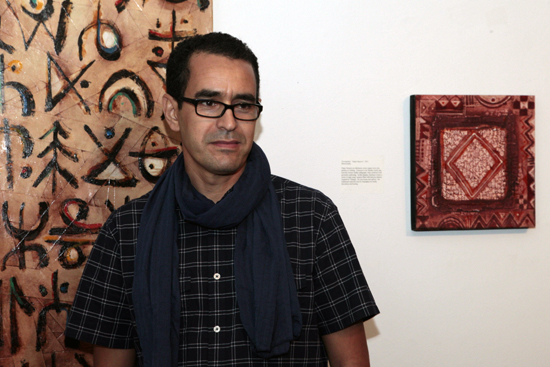Reviving an Ancient Script
Moroccan artist documents struggle for cultural survival Moroccan artist Hamid Kachmar can’t recall a time when he wasn’t drawing and painting. Born into a family of indigenous Berber ancestry, Kachmar uses the symbols and colors of his African heritage to tell the story of his people’s struggle for cultural and linguistic recognition.
Kachmar was 13 when he discovered that his Amazigh Berber language had a script of its own. That ancient script—called Tifinagh—had been politically suppressed for centuries. As recently as the 1950s and 1960s, postcolonial nations, including Morocco, Algeria, Tunisia, and Libya, had refused to acknowledge Tamazight, the spoken language tied to Tifinagh script. For self-proclaimed cultural activist Kachmar, Tifinagh symbolizes not only cultural suppression, but the struggle to hold onto and celebrate cultural identity.
Kachmar has been incorporating Tifinagh script into his work for two decades, using it as a way to help revive and celebrate his Amazigh heritage. In his paintings and mixed works, he renders the script into visual compositions that tell the story of a struggle for identity.
«I want people to know that there’s another dimension to Moroccan culture,» Kachmar says, «because what is promoted, what people know as Morocco, is more like a Middle Eastern country, where there is the hookah, shisha, and belly dancing.»
In the Sherman Gallery’s new show, Hamid Kachmar: Reviving the Ancient Tifinagh Script, on view through October 20, visitors can see for themselves how Kachmar uses art to evoke the story of a culture indigenous to North Africa and the Sahara. The work is divided into three sections, «Land,» «Language,» and «People,» some decidedly political, some deeply personal.
Presented as part of the 60th anniversary celebration of BU’s African Studies Center, the exhibition is curated by Cynthia Becker, a College of Arts & Sciences associate professor of art history. «It’s interesting because we can see this historic struggle of people, and it’s very timely given the Arab Spring,» Becker says.
Among the show’s 19 pieces, one of the most striking is a mixed media work titled Totem I. The title refers to the piles of stones that the Amazigh people used to mark important places—such as where a person died or where an important ceremony was to take place. The use of goatskin, bark cloth, and other unconventional materials gives the piece a wonderful three-dimensional quality.
Hamid Kachmar: Reviving the Ancient Tifinagh Script is at the Sherman Gallery, George Sherman Union, 775 Commonwealth Ave., second floor, through Sunday, October 20. The gallery is open Tuesday through Friday, from 11 a.m. to 5 p.m., and Saturday and Sunday, from 1 to 5 p.m.; phone: 617-358-0295. The exhibition is free and open to the public.
 Reviving an Ancient Script
Reviving an Ancient ScriptSource: www.bu.edu